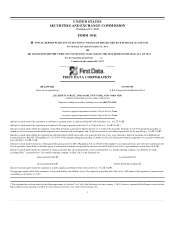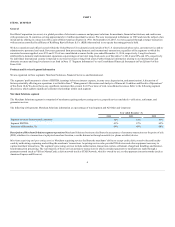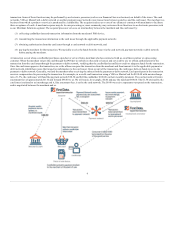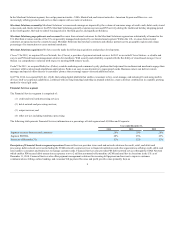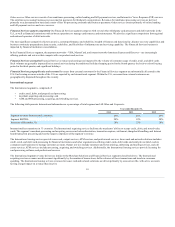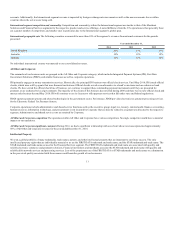First Data 2014 Annual Report Download - page 5
Download and view the complete annual report
Please find page 5 of the 2014 First Data annual report below. You can navigate through the pages in the report by either clicking on the pages listed below, or by using the keyword search tool below to find specific information within the annual report.
Revenues are generated from a variety of sources:
• discount fees charged to a merchant, net of credit card interchange and assessment fees charged by the payment networks. The discount fee is
typically either a percentage of the credit card transaction or the interchange fee plus a fixed dollar amount;
• processing fees charged to unconsolidated alliances discussed below;
• processing fees charged to merchant acquirers who have outsourced their transaction processing to us;
• selling and leasing POS devices; and
• debit network fees.
Most of Merchant Solution’s revenue is derived from regional and local merchants. The items listed above are included in our consolidated revenues and, for
equity earnings from unconsolidated alliances, the “Equity earnings in affiliates” line item in the Consolidated Statements of Operations. The Merchant
Solutions segment revenue and EBITDA are presented using proportionate consolidation; accordingly, segment revenue also includes the alliance partner’s
share of processing fees charged to consolidated alliances. In addition, segment revenue excludes debit network fees and other reimbursable items.
Throughout the document we use the word “partner” to describe situations where we have a contractual relationship with another company. These
relationships do not include equity ownership. In situations where equity ownerships are involved, we generally refer to the arrangement/entity as an
affiliate.
Merchant Solutions provides merchant acquiring and processing services, prepaid services and check verification, guarantee, and settlement services to
merchants that operate approximately 3.9 million merchant locations across the U.S. and acquired $1.7 trillion of payment transaction dollar volume on
behalf of U.S. merchants in 2014. Merchant Solutions provides full service merchant processing primarily for transactions of VISA, MasterCard and a variety
of personal identification number (PIN) debit networks at the POS.
Merchant Solutions approaches the market through diversified sales channels including equity alliances, and its other contractual revenue sharing and/or
referral arrangements with more than 400 financial institution partners, more than 1,700 non-bank referral partners, and more than 600 independent sales
organization partners, as of December 31, 2014. Growth in the Merchant Solutions business is derived from entering into new merchant relationships,
reducing the turnover in existing merchant relationships, new and enhanced product and service offerings, cross selling products and services into existing
relationships, the shift of consumer spending to increased usage of electronic forms of payment, and the strength of our alliances and relationships with banks
and other entities. Our alliance structures take on different forms, including consolidated subsidiaries, equity method investments, and contractual revenue
sharing and/or referral arrangements. Under the alliance and referral programs, the alliance/referral partners typically act as a merchant referral source. We
benefit by providing processing services for the alliance/referral partners and their merchant customers. Both we and the alliance may provide management,
sales, marketing, and other administrative services. The alliance strategy could be affected by consolidation among financial institutions.
Our strategy with banks, independent sales organizations, and referral/sales partners provides us with broad geographic coverage, regionally and nationally,
as well as presence and expertise in various industries. The alliance/referral partner structure allows us to be the processor for multiple financial institutions,
any one of which may be selected by the merchant as their bank partner. Additionally, bank partners provide brand loyalty and a distribution channel
through their branch networks which increases merchant retention.
In 2014, Merchant Solutions rolled out Small Business Solutions (SBS), a program designed to help small to medium sized businesses (SMBs) better manage
their business. The new SBS is integrated into Clover Station, our proprietary tablet-based hardware solution, and allows SMBs to manage inventory, track
revenues, and generate reports that distill transaction data into powerful intelligence. Merchants can customize and grow their Clover Station’s capabilities
by adding applications from the Clover App Market. The SBS also includes features such as analytics, TransArmor, a transaction processing encryption and
tokenization technology, and Perka, a cloud-hosted mobile loyalty marketing program.
There are a number of different entities involved in a merchant transaction including the cardholder, card issuer, card network, merchant, merchant acquirer,
electronic processor for credit and signature debit transactions, and debit network for PIN-debit transactions. The card issuer is the financial institution that
issues credit or debit cards, authorizes transactions after determining whether the cardholder has sufficient available credit or funds for the transaction, and
provides funds for the
5

